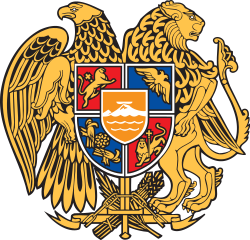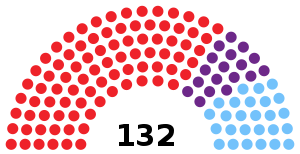Politics of Armenia
The politics of Armenia take place in the framework of the parliamentary representative democratic republic of Armenia, whereby the President of Armenia is the head of state and the Prime Minister of Armenia the head of government, and of a multi-party system. Executive power is exercised by the President and the Government. Legislative power is vested in both the Government and Parliament.[1][2][3]
 | |
| Polity type | Unitary parliamentary republic |
|---|---|
| Constitution | Constitution of Armenia |
| Legislative branch | |
| Name | National Assembly |
| Type | Unicameral |
| Meeting place | National Assembly Building |
| Presiding officer | Ararat Mirzoyan, President of the National Assembly |
| Executive branch | |
| Head of State | |
| Title | President |
| Currently | Armen Sarkissian |
| Appointer | National Assembly |
| Head of Government | |
| Title | Prime Minister |
| Currently | Nikol Pashinyan |
| Appointer | President |
| Cabinet | |
| Name | Government of Armenia |
| Current cabinet | Pashinyan government |
| Leader | Prime Minister |
| Appointer | President |
| Headquarters | Government House |
| Ministries | 12 |
| Judicial branch | |
| Name | Judiciary of Armenia |
| Constitutional Court of Armenia | |
| Chief judge | Hrayr Tovmasyan |
| Seat | Yerevan |
| Part of a series on |
| Armenia Հայաստան |
|---|
  |
| Culture |
| History |
| Demographics |
| Administrative divisions |
|
History
Armenia became independent from the Russian Empire on 28 May 1918 as the Republic of Armenia, later referred as First Republic of Armenia. About a month before its independence Armenia was part of short lived Transcaucasian Democratic Federative Republic. Suffering heavy losses during the Turkish invasion of Armenia and after the Soviet invasion of Armenia, the government of the First Republic resigned on 2 December 1920. Soviet Russia reinstalled its control over the country, which later became part of the Transcaucasian SFSR. The TSFSR was dissolved in 1936 and Armenia became a constituent republic of the Soviet Union known as the Armenian SSR, later also referred as the Second Republic of Armenia.
During the dissolution of the Soviet Union the population of Armenia voted overwhelmingly for independence following the 1991 Armenian independence referendum. It was followed by a presidential election in October 1991 that gave 83% of the votes to Levon Ter-Petrosyan. Earlier in 1990, when the National Democratic Union party defeated the Armenian Communist Party, he was elected Chairman of the Supreme Council of Armenia. Ter-Petrosyan was re-elected in 1996. Following public discontent and demonstrations against his policies on Nagorno-Karabakh, the President resigned in January 1998 and was replaced by Prime Minister Robert Kocharyan, who was elected as second President in March 1998. Following the assassination of Prime Minister Vazgen Sargsyan, parliament Speaker Karen Demirchyan and six other officials during parliament seating on 27 October 1999, a period of political instability ensued during which an opposition headed by elements of the former Armenian National Movement government attempted unsuccessfully to force Kocharyan to resign. In May 2000, Andranik Margaryan replaced Aram Sargsyan (a brother of assassinated Vazgen Sargsyan) as Prime Minister.
Kocharyan's re-election as president in 2003 was followed by widespread allegations of ballot-rigging. He went on to propose controversial constitutional amendments on the role of parliament. These were rejected in a referendum the following May. Concurrent parliamentary elections left Kocharyan's party in a very powerful position in the parliament. There were mounting calls for the President's resignation in early 2004 with thousands of demonstrators taking to the streets in support of demands for a referendum of confidence in him.
The Government of Armenia's stated aim is to build a Western-style parliamentary democracy. However, international observers have questioned the fairness of Armenia's parliamentary and presidential elections and constitutional referendum between 1995 and 2018, citing polling deficiencies, lack of cooperation by the Electoral Commission, and poor maintenance of electoral lists and polling places. Armenia is considered one of the most democratic nations of the Commonwealth of Independent States.
The observance of human rights in Armenia is uneven and is marked by shortcomings. Police brutality allegedly still goes largely unreported, while observers note that defendants are often beaten to extract confessions and are denied visits from relatives and lawyers. Public demonstrations usually take place without government interference, though one rally in November 2000 by an opposition party was followed by the arrest and imprisonment for a month of its organizer. Freedom of religion is not always protected under existing law. Nontraditional churches, especially the Jehovah's Witnesses, have been subjected to harassment, sometimes violently. All churches apart from the Armenian Apostolic Church must register with the government, and proselytizing was forbidden by law, though since 1997 the government has pursued more moderate policies. The government's policy toward conscientious objection is in transition, as part of Armenia's accession to the Council of Europe.
Armenia boasts a good record on the protection of national minorities, for whose representatives (Assyrians, Kurds, Russians and Yazidis) four seats are reserved in the National Assembly. The government does not restrict internal or international travel.
Transition to a parliamentary republic
In December 2015, the country held a referendum which approved transformation of Armenia from a semi-presidential to a parliamentary republic.[4]
As a result, the president was stripped of his veto faculty and the presidency was downgraded to a figurehead position elected by parliament every seven years. The president is not allowed to be a member of any political party and re-election is forbidden.[5]
Skeptics saw the constitutional reform as an attempt of third president Serzh Sargsyan to remain in control by becoming Prime Minister after fulfilling his second presidential term in 2018.[4]
Government
| Office | Name | Party | Since |
|---|---|---|---|
| President | Armen Sarkissian | Independent | 9 April 2018 |
| Prime Minister | Nikol Pashinyan | Civil Contract | 8 May 2018 |
Legislative branch
The unicameral National Assembly of Armenia (Azgayin Zhoghov) is the legislative branch of the government of Armenia.
Before the 2015 Armenian constitutional referendum, it was initially made of 131 members, elected for five-year terms: 41 members in single-seat constituencies and 90 by proportional representation. [6] The proportional-representation seats in the National Assembly are assigned on a party-list basis among those parties that receive at least 5% of the total of the number of the votes.
Following the 2015 referendum, the number of MPs was reduced from the original 131 members to 101 and single-seat constituencies were removed.[5]
Political parties and elections
The electoral threshold is currently set at 5% for single parties and 7% for blocs.[7]
Latest national elections
 | |||||
| Party | Votes | % | Seats | +/– | |
|---|---|---|---|---|---|
| My Step Alliance | 884,864 | 70.42 | 88 | +83 | |
| Prosperous Armenia | 103,801 | 8.26 | 26 | –5 | |
| Bright Armenia | 80,047 | 6.37 | 18 | +15 | |
| Republican Party of Armenia | 59,083 | 4.70 | 0 | –58 | |
| Armenian Revolutionary Federation | 48,816 | 3.88 | 0 | –7 | |
| We Alliance (FD–H) | 25,176 | 2.00 | 0 | –1 | |
| Sasna Tsrer | 22,868 | 1.82 | 0 | New | |
| Rule of Law | 12,393 | 0.99 | 0 | 0 | |
| Citizen's Decision | 8,514 | 0.68 | 0 | New | |
| Christian-Democratic Rebirth Party | 6,458 | 0.51 | 0 | New | |
| National Progress Party | 4,121 | 0.33 | 0 | New | |
| Invalid/blank votes | 5,111 | – | – | – | |
| Total | 1,261,105 | 100 | 132 | +27 | |
| Registered voters/turnout | 2,593,140 | 48.63 | – | – | |
| Source: CEC | |||||
Latest presidential elections
Independent agencies
Independent of three traditional branches are the following independent agencies, each with separate powers and responsibilities:[8]
- the Constitutional Court of Armenia
- the Central Electoral Commission of Armenia
- the Human Rights Defender of Armenia
- the Central Bank of Armenia
- the General Prosecutor's Office
- the Audit Chamber of Armenia
Corruption
Political corruption is a problem in Armenian society. In 2008, Transparency International reduced its Corruption Perceptions Index for Armenia from 3.0 in 2007[9] to 2.9 out of 10 (a lower score means more perceived corruption); Armenia slipped from 99th place in 2007 to 109th out of 180 countries surveyed (on a par with Argentina, Belize, Moldova, Solomon Islands, and Vanuatu).[10] Despite legislative revisions in relation to elections and party financing, corruption either persists or has re-emerged in new forms.[11]
The United Nations Development Programme in Armenia views corruption in Armenia as "a serious challenge to its development."[12]
See also
Notes
- Shugart, Matthew Søberg (September 2005). "Semi-Presidential Systems: Dual Executive and Mixed Authority Patterns" (PDF). Graduate School of International Relations and Pacific Studies. United States: University of California, San Diego. Archived from the original (PDF) on 19 August 2008. Retrieved 13 October 2017. Cite journal requires
|journal=(help)CS1 maint: ref=harv (link) - Shugart, Matthew Søberg (December 2005). "Semi-Presidential Systems: Dual Executive And Mixed Authority Patterns" (PDF). Graduate School of International Relations and Pacific Studies, University of California, San Diego. French Politics. 3 (3): 323–351. doi:10.1057/palgrave.fp.8200087. ISSN 1476-3427. OCLC 6895745903. Retrieved 13 October 2017.
Table 1 shows that dissolution power as a presidential initiative is rare in the contemporary president-parliamentary systems. In fact, only in Armenia may the president dissolve (once per year) without a trigger (e.g. assembly failure to invest a government).
CS1 maint: ref=harv (link) - Markarov, Alexander (2016). "Semi-presidentialism in Armenia". In Elgie, Robert; Moestrup, Sophia (eds.). Semi-Presidentialism in the Caucasus and Central Asia. London: Palgrave Macmillan UK (published 15 May 2016). pp. 61–90. doi:10.1057/978-1-137-38781-3_3. ISBN 978-1-137-38780-6. LCCN 2016939393. OCLC 6039792321. Retrieved 8 October 2017.
Markarov discusses the formation and development of the semi-presidential system in Armenia since its foundation in 1991. The author identifies and compares the formal powers of the president, prime minister, and parliament under the 1995 Constitution as well as the amendments introduced through the Constitutional referendum in 2005. Markarov argues that the highly presidentialized semi-presidential system that was introduced in the early 1990s gradually evolved into a Constitutionally more balanced structure. However, in practice, the president has remained dominant and backed by a presidential majority; the president has thus been able to set the policy agenda and implement his preferred policy.
CS1 maint: ref=harv (link) - Ayriyan, Serine (April 2016). "Armenia a gateway for Iranian goods?". ControlRisks | Russia/CIS Riskwatch Issue 9. Retrieved 20 April 2016.
- "Majority of Voters Support Armenia's Constitutional Reform". Sputnik. 7 December 2015. Retrieved 19 December 2016.
- https://armenianweekly.com/2015/12/07/constitutional-amendments-approved/
- Sanamyan, Emil. "A1 Plus, ARFD Nominates Vahan Hovhannisyan". Open Democracy. Retrieved 2017-03-28.
- http://www.atb.am/en/armenia/country/
- Global Corruption Report 2008, Transparency International, Chapter 7.4, p. 225.
- 2008 CORRUPTION PERCEPTIONS INDEX Archived 2009-03-11 at the Wayback Machine, Transparency International, 2008.
- Global Corruption Report 2008, Transparency International, Chapter 7, p. 122.
- "Strengthening Cooperation between the National Assembly, Civil Society and the Media in the Fight Against Corruption", Speech by Ms. Consuelo Vidal, (UN RC / UNDP RR), April 6, 2006.
External links
- Global Integrity Report: Armenia has information on anti-corruption efforts
- Petrosyan, David: "The Political System of Armenia: Form and Content" in the Caucasus Analytical Digest No. 17
- https://web.archive.org/web/20180523075014/http://www.coc.am/LegislationEng.aspx
- https://web.archive.org/web/20170519193353/http://www.coc.am/files/legislation/COCLawArm.pdf
- http://www.parliament.am